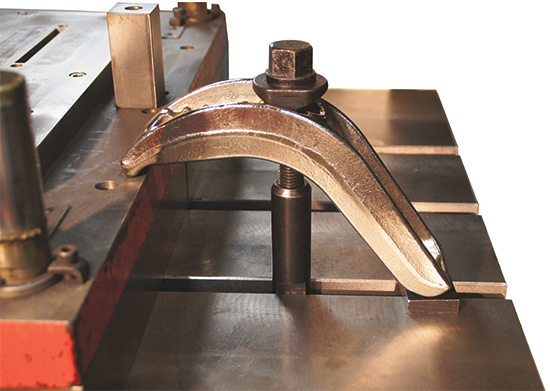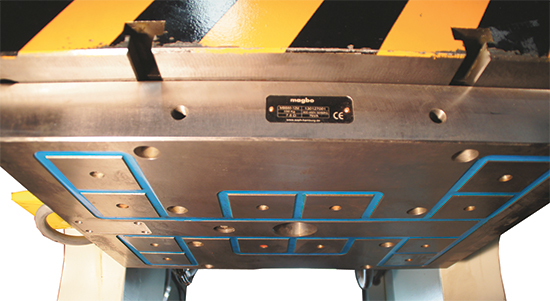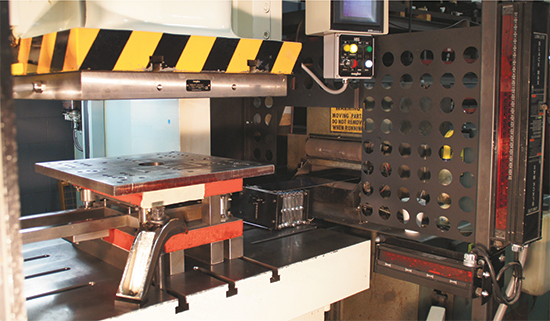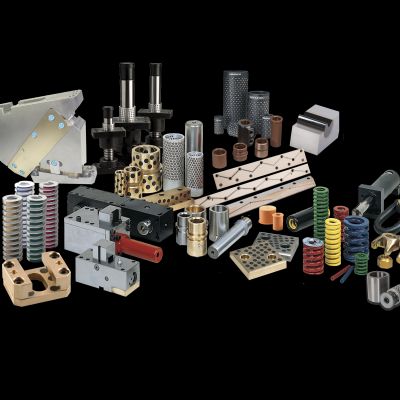Discussion of future tools further narrowed press selection. In the end, Atlas installed (in June 2013) a 165-ton Aida gap-frame press with 30- by 46-in. bed and 7.87-in. stroke, rated at 30 to 60 strokes/min.
 |
| The Lenzkes clamp is height-adjustable from 3.5 to 7.2 in. The design ensures that the 6.7 tons of clamping force is directed downward on the tool with zero side force. Note the tall T nut that allows the bolt head to stay on top of the clamp regardless of clamp height. |
Regarding die-change technology, the tendency is to focus on the clamps themselves—mechanical, hydraulic or magnetic clamping—because they are the products that the end user buys, so the costs are clear. All three technologies have their place, with advantages and disadvantages to each and calculating their relative is quite simple.
What is not simple is identifying the hidden costs of tooling modifications that may be required. For example, if there are a substantial number of legacy tools, tooling-modification costs can be many times higher than new clamping technology.
Atlas’ legacy tooling had been clamped to the press ram using bolts dropped through the ram plate into tapped holes in the top of the tools. The lower tools had been clamped using traditional strap clamps with heel blocks that varied in height to position the clamp to match the tool. There was no common clamping height for the lowers, positioned anywhere from 3.5 to 4.5 in. from the die plate; lower tools were on parallels with no quick-die-change plates.
In addition to the tooling, Atlas wanted its next press to have more tonnage capacity.
“We wanted not only to be able to run legacy tools, but saw value in increasing press size so we could use the press for larger parts in the future,” Engel says.
|
Atlas Precision at a Glance
Headquarters: Minneapolis, MN; more than 75,000 sq. ft. of manufacturing space among plants in Minn. and Wis.
Founded: 1962
Capabilities: Contract manufacturing, precision sheetmetal fabrication, powder coating, engineering and design, assembly and logistic support, machining
Certification: ISO 9001:2008
Industries served: Telecommunications, retail, store fixtures, computers, electronic data racking and enclosures, industrial products, medical and commercial applications.
|
An increase in tonnage capacity would mean a larger ram, making it impossible to put holes in the ram of the new press that matched the old tooling’s tapped-hole locations.
Several proposed new tools would be as large as the new ram, so there was no to use mechanical clamps that need to rest a heel on the ram face next to the tool. And none of the tools had slots milled into them that would line up with the new press’s T slots.
The Right Clamp Style for the Job
There was one common feature for all the tools, though: a flat steel surface on the top. This made magnetic clamping (from Soph Magnetics, Inc., Brighton, MI) for the upper a simple choice. It required no die modification of any sort, a big savings compared to what would have been needed if hydraulic or mechanical clamps were used.
For the lower tool, though, magnets were not an easy option. With the tools on parallels, it was possible to clamp with magnets, but the investment would be much higher than if the tools were on plates. The number of tool changes per shift in this application did not justify the cost to use the more expensive magnetic clamping required for parallel-mounted tools.
And, because clamp height varied by as much as 1 in. from tool to tool, hydraulic clamps were not possible without substantial tooling changes that meant higher costs.
That left mechanical clamps, which have seen recent noteworthy upgrades in technology. For its new Aida press, Atlas went with adjustable mechanical clamps (Model S40 clamps from Lenzkes Clamping Tools, Christiansburg, VA) with 13,400 lb. of clamping force and height-adjustable from 3.5 to 7 in., which eliminated the need for separate height heel blocks. Their design allowed a wide clamp-height range by adjusting the height of the bolt which passes through the forged steel frame of the adjustable clamp into a special T nut. With no separate pieces to be stored, the system proves simpler than older styles of clamps, and faster to set up.
 |
| Force from the magnetic clamping system comes through the poles surrounded with the blue resin. The poles are distributed to hold the smallest tools as well as the largest tools. |
It also eliminated potential errors that sometimes are seen with the older-style strap clamps, where a short heel block could cause the clamp to put sidewise thrust on the tool, or the heel would be placed too close to the bolt so the clamping force was directed to the heel and not the tool itself.
“The Lenzkes clamps provide a faster clamping method than we previously had,” Engel says. “Their mistake-proofing elements also were attractive. Looking for opportunities to improve is an important part of our culture at Atlas.”
So, the eventual die-clamping solution combined Soph magnetic clamping on the ram for the upper tools and Lenzkes mechanical clamps for the lower tools. That allows rapid clamping and no modifications to legacy dies.
Savings Coming from Every Direction
Atlas saved more than just materials and labor by avoiding tooling modifications, Engel says.
“Modifying our existing tools could have created interruptions in production,” he says. “Tools may have been needed before we could have gotten them modified. The solution we went with allowed a fast, seamless conversion from running on the old press to the new.”
With the decisions made for die clamping, TCR provided a plan to move the new press and related equipment into the Atlas pressroom. TCR’s technicians installed the magnets, set up all of the guarding, and integrated the existing feed line to the new press in just a few days.
The swift startup meant no disruptions in product flow and no delays for Atlas customers. Being able to provide skilled trades staff and project management to customers such as Atlas, to turn technology recommendations into reality on the floor, has been critical to TCR’s growth.
And, the improvement in die-swap times isn’t the only benefit Atlas has seen from the changes.
“At first our employees were leery of a magnetic plate holding the upper die,” Engel says. “Now they insist that our next press utilize the same technology for die clamping.” MFIndustry-Related Terms: Plate,
Powder Coating,
Ram,
Die,
LASER,
Run,
Shut Height,
Stroke,
Surface,
CNC (Computer Numerical Control),
BedView Glossary of Metalforming Terms
See also: TCR-Integrated Stamping Systems, Aida-America Corp., Lenzkes Clamping Tools, Inc., SOPH, Inc.
Technologies: Stamping Presses, Tooling











